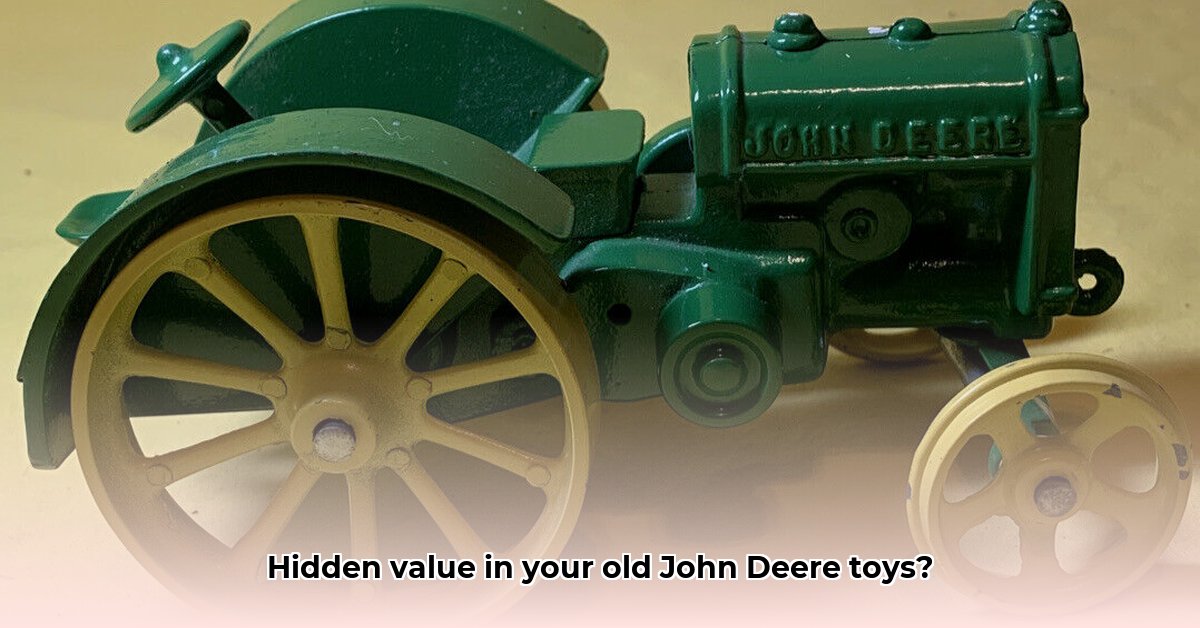
John Deere Toy Tractor Antiques: A Collector's Guide
John Deere toy tractors are more than just childhood playthings; they're coveted collectibles with a fascinating history. This comprehensive guide provides actionable steps for identifying, evaluating, and preserving these miniature marvels of agricultural heritage. Whether you're a seasoned collector or a curious beginner, this guide will equip you with the knowledge to confidently navigate the world of antique John Deere toy tractors. For even more information on modern John Deere toys, check out this helpful resource.
Dating Your Antique John Deere Toy Tractor
Determining the age of your John Deere toy tractor requires a keen eye for detail. While explicit dates are rarely stamped on these items, several clues reveal the age:
Manufacturing Method: Older tractors, often made using sand casting (a process involving pouring molten metal into sand molds), often exhibit minor imperfections like slight bumps or uneven surfaces. These imperfections are absent from the more precise manufacturing methods used in later models.
Paint Type and Application: Enamel paint was commonly used on early tractors. This type of paint tends to chip and wear differently compared to the more durable acrylic paints used in later production. Examining the paint's texture, color, and wear patterns can provide valuable clues.
Comparative Analysis: Consult online resources like specialized collector forums and online marketplaces (like eBay) to compare your tractor against known examples. Observing subtle variations in design, color, and features often reveals chronological differences. Remember, building expertise takes time and dedicated research.
Assessing Condition: A System for Valuation
The condition of your antique John Deere toy tractor significantly influences its value. A standardized grading system helps to objectively assess its worth:
| Condition Grade | Description | Value Impact |
|---|---|---|
| Excellent | Pristine condition; minimal to no wear; original paint in excellent shape. | Highest Value |
| Very Good | Minor wear and tear; original paint mostly intact; all parts present. | High Value |
| Good | Some wear and tear; some paint loss; complete. | Moderate Value |
| Fair | Significant wear; considerable paint loss; may have been repaired. | Low Value |
| Poor | Extensive damage; significant paint loss; missing parts. | Very Low Value |
High-quality photographs are essential when selling. Document every detail, including minor imperfections. Transparency builds trust with potential buyers. Isn't honesty always the best policy in a transaction?
Spotting Fakes: Identifying Authentic Tractors
The market for collectible John Deere tractors includes reproductions. While replicas can be enjoyable in their way, they typically command significantly lower prices than authentic antiques. Here's how to differentiate:
Casting Imperfections: Authentic antique tractors often show slight imperfections and irregularities characteristic of older manufacturing processes. Reproductions generally have a smoother, more uniform finish.
Paint Analysis: Compare the paint job to known originals. Reproductions sometimes boast a too-perfect finish, lacking the subtle aging and wear of authentic antiques.
Cross-Referencing: Use reference books or compare your tractor to verified originals found online. When in doubt, consult experienced collectors for verification.
Market Research: Determining Your Tractor's Value
Online marketplaces like eBay are invaluable for market research. Search for comparable tractors, paying close attention to condition, included accessories, and the seller's descriptions. Consider the use of collector jargon, such as "near mint" or "original box," which significantly impacts pricing. Expand your research to dedicated collector forums and auction sites for a comprehensive market overview. Remember, market prices fluctuate; ongoing research is crucial for accurate valuation. Have you considered the impact of seasonal demand on pricing?
Cleaning and Preservation: Gentle Care for Lasting Beauty
Proper cleaning and storage are essential for preserving your tractor's value and aesthetics.
Cleaning: Use a soft brush and mild soapy water. Avoid harsh chemicals or abrasive cleaners. Never scrub aggressively.
Storage: Store your tractor in a cool, dry place away from direct sunlight and dust. Protective display cases preserve valuable models.
The Importance of Accessories and Provenance
Beyond the tractor itself, original accessories like boxes, manuals, and sales receipts substantially increase its value. These items add to the historical narrative. Establishing provenance (the history of ownership) also significantly enhances a tractor's authenticity and value. Doesn't knowing the history of your piece add a layer of fascination?
Conclusion: Passion, Patience, and Expertise
Collecting antique John Deere toy tractors is a rewarding pursuit blending passion, careful research, and a keen eye for detail. Building expertise takes time and dedication, but understanding your tractor's history and value is deeply satisfying. The market constantly evolves, so continuous learning is key to appreciating these charming collectibles. Isn't the journey of discovery as valuable as the treasures themselves?
Key Takeaways:
- The value of vintage John Deere toy tractors depends on several factors, including age, materials, paint, condition, accessories, and market demand.
- Identifying reproductions requires detailed examination of manufacturing techniques and paint analysis.
- Online research and consultation with experienced collectors are invaluable for accurate valuation.
- Proper cleaning, storage, and documentation preserve and enhance your tractor's value.